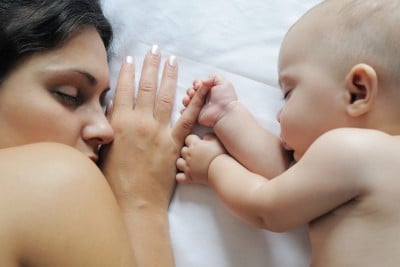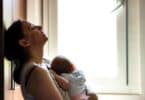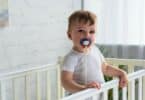Co-sleeping hasn’t always been a hot topic. There once was a time when, among most cultures, bed sharing wasn’t just acceptable – it was the societal norm. Even today, there are countries in which co-sleeping is still considered the cultural norm. But in the developed world, the debate of whether or not to co-sleep is one that stirs heated conversations, both in person and on the internet. Now there is a new study that is likely to rouse some serious commotion – one in which researchers said that co-sleeping increases and infant’s risk of SIDS by five-fold.
Published in the British Medical Journal Open, the new study analyzed 1,472 Sudden Infant Death Syndrome (SIDS) cases and 4,679 control cases from Australia, the UK and Europe. News.com.au called it the largest study on cot death to date.
Led by Professor Robert Carpenter, the researchers say that infants are five times more likely to die of SIDS if they co-sleep with their parents, even if their parents aren’t smokers. They also say that this risk extends to babies that have previously been thought to have a less of a risk of SIDS while co-sleeping (ex: babies that are breastfed or babies whose mothers have not consumed drugs or alcohol prior to falling asleep).
According to the researchers, the SIDS death rate would “plummet” if parents stopped bed sharing and public health messages were more forceful about the dangers surrounding co-sleeping, particularly for infants under the age of three months.
“Eighty percent of the deaths that occurred while bed sharing would probably not have occurred, had the baby been placed on its back in a cot by the parents’ bed,” the authors said.
Jill Green from the safe sleeping organization, SIDS and Kids, who was not involved in the study, backs this information and recommends that infants sleep on their backs in their own cots next to their parent’s beds for the first six to twelve months.
“Sharing sleeping surfaces with a baby can increase the risk of not only SIDS but also fatal sleeping accidents,” Green told News.com.au. “We need to take both of those into consideration. There are as many fatal sleep accidents as there are little ones dying from SIDS. We need to go further and inform parents about what is a safe sleeping environment and what is not so they can make an informed choice.”
Separate sleeping for mothers and babies has only been around for about two centuries (Davies, L. (1995). “Babies co-sleeping with parents.” Midwives: Official Journal of the Royal College of Midwives, 108, 384-386), but Western cultures, as well as other developed cultures, have adopted the practice of separate sleeping space for better safety and more privacy, among other reasons.
Researchers on the latest study say there’s been a shift in that practice, and that co-sleeping rates in developed countries have increased “markedly” over the last decade. They say that parents who endorse the practice are active on the internet and social network outlets. However, Murdoch University associate professor, Catherine Fetherson, believes these parents are being driven underground because of the blanket messages against co-sleeping.
“They are continuing to do it, even though people are being warned against it, and so what is happening is they are shutting down all communication with health professionals,” Featherson told News.com.au. “We don’t have the opportunity to talk to them about how they can do it safely and how they can minimize the risks associated with it.”
Considering the fact that Featherson says that research estimates somewhere between 30 and 50 percent of all parents co-sleep at some point, that’s a lot of parents that aren’t receiving the message of how co-sleeping can be done safely.
So, can it be done safely?
Though there is a great deal of evidence against it, there are many parents and experts who will tell you that co-sleeping can be done safely. Experts like Dr. Sears, Attachment Parenting supportive doctor, who says that there are seven key benefits to co-sleeping, and that it can be done in a way that helps reduce the risk of SIDS.
According to Dr. Sears:
- Parents can make their beds a safer place for baby by using fitted sheets on their mattresses and removing all fluffy blankets and pillows that could pose a risk to baby. Parents should also avoid waterbeds, damaged beds, or beds with holes. Also, there shouldn’t be any gaps (even ones that you think baby would be too big to fit through) between baby and the wall.
- Parents who have consumed alcohol, drugs, or have taken medications that may alter sleep patterns should not co-sleep. Additionally, parents that are over-tired should put the baby in their own cot because exhaustion can keep you from waking up at night.
- Items that could wrap around baby – jewelry, strings, cords, etc. – should be removed from your person, your clothing and your bed before co-sleeping. Any of these items could create a hazard for your baby. Babies should not be swaddled while co-sleeping either.
- Parents who wish to co-sleep should be very mindful of the temperature of their room. A room that is too cold could encourage parents to pull the blankets up in their sleep, putting baby at a higher risk. And rooms that are too warm could cause baby to overheat while snuggled against an adult.
- Co-sleeping should never be done on a couch or chair. Baby can become trapped in between baby and the furniture. Additionally, furniture can make it easier for the baby to roll off onto the floor.
Any sleeping location can be unsafe for a baby. And babies can die of SIDS, regardless of where they are sleeping. So, whether you choose to co-sleep or place your baby in a separate location, you should know the difference between safe and unsafe sleeping conditions. In the end, every parent has to make their own choice – and that applies to almost every aspect of parenting.
Although I would not consider myself an advocate, I’m definitely not a person that speaks out against co-sleeping since I shared a bed with all five of my children. My youngest still finds himself in our bed from time to time. Was I right? Did I make a mistake? I honestly can’t say, other than the fact that all of my children are healthy and safe.
Related Articles:
- Researchers Suspect 3 “S’s” to Be Contributing Factors in Rise of ADHD Rates
- Only 25% of All Sunscreens Provide Long-Lasting, Quality Protection
- Study: Breastfeeding may Decrease ADHD Risks







